Menus
- The era of e-Total Control
- Discovery
- In the saddle
- On track
- Conclusion
- The Honda CBR 1000 RR Fireblade video test
The era of e-Total Control
A quarter of a century has seen the evolution of one of the most efficient and unique sports cars in the segment: the CBR Fireblade. It is also a commercial success with the 470,000 units sold since 1992. The very first appears then, cubing 893 cc and has since become an icon of the family.. Already at the time, the machine stood out, not reaching the liter of Suzuki GSX-R 1000 and other FZR 1000. But the Honda then offered a concept, "total control", basic line but also a true design philosophy. of its sports models. This precept was already based on the weight-to-power ratio. Thus, the water-cooled 4-cylinder, dual ACT, 16-valve, weighed just 68 kg, the whole machine 188 kg for 124 hp. And the efficiency was bluffing, as were the sales, this first model accumulating 26,000 units.
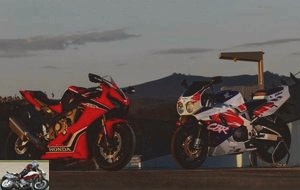 Two generations of Fireblade
Two generations of Fireblade
The CBR then receives, over the years, a number of major developments (over 8 vintages in total), both aesthetic and technological. The 1994-1999 opus saw its displacement increased to 916 cc, its frame modified. Big step forward for 2000-2001, 929 cc models with PGM-FI injection and an entirely new chassis.
Lighter and more powerful, the 2002-2003 machines go to 954 cc and improve their aerodynamics. The lines are tense, aggressive. The 2004-2005 and 2006-2007 CBR-RRs are constantly evolving towards an angular, racing style and the exhaust migrates under the saddle. Important aesthetic break for the years 2008-2011. The front is hypercompact, almost vertical and clashes positively in the competition. New perimeter frame, quiet almost under the machine, anti-dribble clutch and C-ABS coupled braking available.
In 2012, the Fireblade returned to a sharper fork crown and its boiler delivers 178 hp and 11.2 da.Nm of torque. An SP version, equipped with Ohlins and Brembo the second in 2014 and only C-ABS and steering damper still electronize the machine. The user is the sole master on board, despite much less conservative competition.
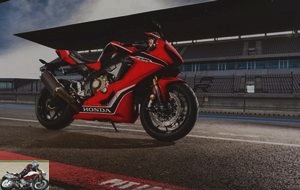 Honda CBR 1000 RR Fireblade review
Honda CBR 1000 RR Fireblade review
Because here it is, the era is with multiple assistance, a guarantee of performance with real pieces of MotoGP inside…. The Japanese "craftsman" specializing in blades of fire therefore had to put chips in his sake. And if the 2017 novelty still respects the philosophy of the original model, the CBR1000RR Fireblade now combines its dogma with a vast advanced electronic arsenal. This guides the acceleration, braking and cornering phases and defines an evolution of its concept into "Next Stage Total Control". The novelty is also supported by a super-equipped SP version with Ohlins piloted suspensions and optimized cycle part (titanium tank, Brembo brakes).
To present its new curve chisel, Honda invites us to the Portimao circuit (Portugal) whose hilly layout will see us test the standard and SP1 versions. Several renowned guests accompany us on the track. Mr. Freddie Spencer, Steve Plater and Sebastien Gimbert, endurance driver with multiple victories and expert of the Lusitanian circuit.
Discovery
Elegance is another of the qualities of CBRs and novelty raises the bar even further in this regard. Fluidity, lightness and sportiness are the key words, carried by a more incisive and complex design taking care of the details of style and limiting the surfaces. Thus, the design is refined and significantly narrows the machine, almost uniting the LEDS lights in an angular optic, highlighted by spoilers, making up a tapered muzzle. The sportswoman becomes a diva, her dress dressing her as close as possible to its compact structure. Thus, on both sides, the sides curve around the front face, seem to rise to the assault of the fork head, forming fins in the upper part. In fact, these contribute to high speed stability. Fixing their tops to the side of a strongly curved bubble, they seem to plunge the front face even more. These sharper lines remain fluid and improve aerodynamics while reducing side surfaces. Thus, at the level of the screen, the total width loses 24 mm and the sides 18 mm.
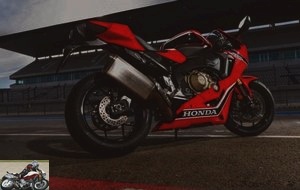 2017 Honda CBR 1000 RR Fireblade
2017 Honda CBR 1000 RR Fireblade
Less effort for better steering, that is the promise. The weight / power ratio improves by + 14% while switching to euro 4 standards !
Visually, the weight reduction is obvious, thus highlighting a real weight loss (- 15 kilos) compared to the previous model. Aesthetics is only one of the many evolutions. Thus, 90% of the main components of the previous machine have been changed, in an absolute search for weight savings on each element and always optimal handling. More angular, the 16-liter tank loses more than one unit, takes on multiple lines and reduces its volumes at the junction with the new cast aluminum rear buckle. On this rest the pilot and passenger seats redesigned, resting on two perforated aluminum spars in the lower part and bolted on an imposing "Diamond" type enveloping frame of the same material..
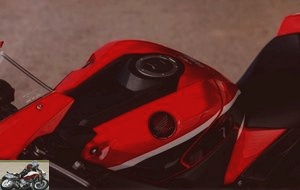 The tank carries 16 liters of fuel
The tank carries 16 liters of fuel
This structure supports a 999.8 cc, twin ACT, 16-valve, in-line four cylinder, Euro4 standard. The mechanics have undergone an important regime for ever more dynamism. Crankshaft, camshafts and transmission are lightened and the piston crown has been redesigned to increase compression. Finally, the diameter of the intake bodies increases and the more compact airbox sees its flow optimized. These developments allow the maximum engine speed to increase, as well as the power, increased by 14 units, going to 192 hp at 13,000 rpm (against 178 at 12,500 revolutions) and the engine force is 11.4 da. Nm at 11,000 revolutions. In total, the Honda block loses two kilos, of which 50% on the lightening of small parts. Titanium exhaust, magnesium cylinder head and ignition cover and aluminum clutch participate in the major gains. The clutch is anti-dribble, but the quick-shifter (up and down) is optional on the standard version.
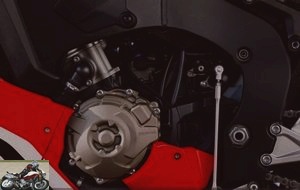 The 4-cylinder of the Fireblade now delivers 189 hp
The 4-cylinder of the Fireblade now delivers 189 hp
But THE novelty is of course the electronic contribution. A revolution in the land of Total Control, chips now occupy a large place within the machine. A Bosch MM5.10 5-axis inertial unit (IMU) controls the other assistances which each communicate with each other: HSTC traction control (Honda Selectable Torque Control), new full ABS anti-lock system, RLC system which prevents the rear wheel from rolling. relieve braking under the effect of load transfer or wheeling, engine brake control (EB) and adoption of a TBW electronic accelerator with APS position sensor ….
The imposing swing arm refines its structure and torsional rigidity while becoming lighter. The suspension uses a Showa Balance Free Rear Cushion (BFRC) type monoshock at the rear and a 43mm Showa BPF (Big Piston Fork). Both are fully configurable in preload, compression and rebound. The steering also receives an electronic damper.
 The swingarm of the Honda CBR 1000 RR Fireblade
The swingarm of the Honda CBR 1000 RR Fireblade
Finally, new Tokico radial front calipers with 4 pistons and radial cylinder matte. They attack 320mm frets. The new 17-inch 5-split-spoke aluminum rims save another 100 gr. They are fitted with Bridgestone S21 F and S21 R tires in 120 and 190.
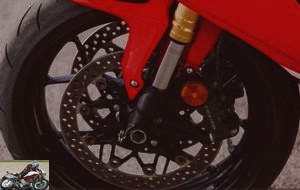 The Fireblade receives Tokico 4-piston radial calipers
The Fireblade receives Tokico 4-piston radial calipers
More regrettable, the exhaust silencer, previously placed under the machine, migrates into a more usual right side position. Less well integrated, its faceted volumes remain however pleasing to the eye, especially since, made of titanium, it also saves weight: 2.8 kilos all the same. !
And as usual with Honda, finishes and assembly of the elements are flawless. The same goes for the surface aspects of different materials. We thus note the matt bronze color of the magnesium (ignition) and aluminum (clutch) casings with a worked design, challenging with the black livery enveloping the standard Fireblade. Frame, buckle, rims and arms are dressed in shadow. We also note the perfect integration of peripherals, cables and hoses are barely visible. The fairings feature many facets and styling details, all of the lighting uses diodes, and the mirrors incorporate turn signals.
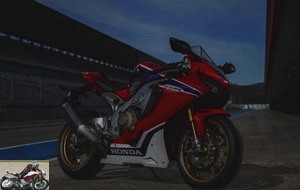 The Honda CBR 1000 RR Fireblade SP
The Honda CBR 1000 RR Fireblade SP
The Fireblade SP version is even more attractive. Frame and buckle leave the aluminum bare and the swingarm is polished while the aluminum rims receive a gold treatment. The SP is equipped with a titanium tank (world first) and a Li-ion battery to lose 1.3 and 1 kg respectively. Its controlled Ohlins suspensions, however, make it lose a little of this benefit, the SP showing however a kilo lighter in the end with 195 units ready to roll. All details in the Technical section.
In the saddle
Very compact, the CBR1000RR is a small motorcycle, thin, narrower at the crotch than the previous model. The position is up to the standards of the genre, but the machine increases its saddle height with 832 mm (+12 mm). However, the pressure on the wrists is not too excessive. There is a brake lever adjustable in spacing, but not the clutch, whose control is cable. Neat, the upper yoke takes again the bronze color of the crankcases, alongside the fork caps supporting the adjustment devices.
The Fireblade has a large, latest generation TFT color liquid crystal display for instruments, which automatically adjusts to ambient light. The screen offers 3 different displays: City, Track and Maintenance, each organizing the (very large) information in the most appropriate way according to the chosen use.
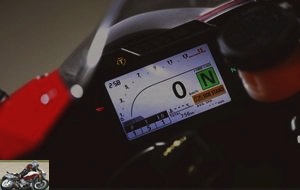 Honda CBR 1000 RR Fireblade instrumentation
Honda CBR 1000 RR Fireblade instrumentation
"City" displays the driving modes (Modes 1 to 3 and User 1 and 2) plus the settings of the parameters P (power), T (torque control) and SEB (engine brake), as well as tachometer, engine speed, gear engaged, water temperature, fuel gauge and odometer and two partials. At the bottom right of the screen, the pilot can choose to display instantaneous or average fuel consumption on routes A or B, average speed and the time elapsed since the ignition was switched on. Also, we will read the amount of fuel remaining after switching to reserve and all this thanks to the calculation of the computer on the dashboard.
In the center right of the screen, the pilot can choose to display gear change settings, throttle angle, battery voltage, date or pre-recorded text. Switching from one mode to the other is controlled by a control placed on the left stalk. Just above is a directional pusher to scroll through the info.
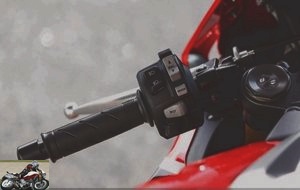 The driving modes are selected from the left comodos
The driving modes are selected from the left comodos
The "Track" mode organizes the display according to a typified and simplified ergonomics. It adds the lap times, the number of laps completed and the difference from the best lap covered. Finally, the "Maintenance" mode displays a digital tachometer, the gear engaged, the throttle opening, the engine temperature and the battery voltage.
In the 2 "User" modes, all parameters can be combined and adjusted freely; the driving mode, the HSTC and suspension settings can be changed while driving using the button on the left stalk. Finally, a configurable shiftlight is composed of 5 white diodes placed at the top of the screen.
On track
The machines heat up quietly in an ample and sporty rumbling, awaiting hostilities. We start the test with two first sessions of 20 minutes on the handlebars of the standard Honda CBR1000RR Fireblade and original tires. The electronics are in Mode 2, setting power P, traction T and engine brake (EB) on values 2, 5 and 3 (As a reminder: P from 1 to 5, T from 1 to 9 and disconnectable, EB from 1 to 3; see Technical article)
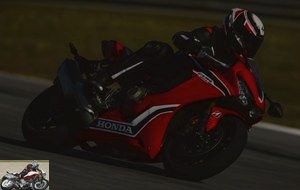 The 2017 Fireblade on the track
The 2017 Fireblade on the track
From the outset, the grip is obvious, making rediscovering the circuit easier and highlighting the intuitive aspect of the Honda hypersport. Its pocket-sized missile with studied ergonomics gives great freedom to its handlebars. As it warms up, the machine is forgotten, leaving the pilot to concentrate on the track. Quickly, the rolling is done faster, quickly giving all the measure of the novelty. It is primarily the weight / power ratio that speaks. Now with 192 hp, the CBR1000RR catapults machine and pilot with new vigor and over a wider rev range. The management of the power modes is very efficient. The most efficient (1) really transforms the CBR into a war machine while the softer (5) makes it a very considerate sports car with progressive acceleration, ideal for a novice on the track. The 15 pounds lost significantly improve the behavior of the machine in all the essential driving phases: braking, cornering, acceleration..
But this is also where the battery of assistance also optimizes efficiency. The typical diagram is as follows, the quick-shifter makes you drop the gears, the ABS watches over the rear wheel lift (RLC) and deceleration even when cornering, the traction control (HSTC) manages the wheel slip. rear wheeling and the possible wheeling and finally we go up the gears without touching the clutch lever. In practice, the strongest decelerations in a straight line make the ABS work quite clearly and, despite the RLC, the rear wheel then gently sweeps the ground and is slow to get back into line. A little too flexible in compression, the Showa fork deserves to be braked more hydraulically, the shock absorber in rebound. Simple adjustments to make on these quality elements.
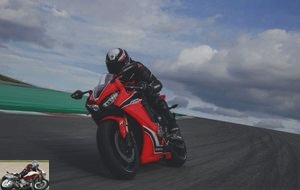 The Honda CBR 1000 RR Fireblade under acceleration
The Honda CBR 1000 RR Fireblade under acceleration
Likewise, the HSTC turns out to be quite permissive, letting the Fireblade draw a few commas on the go-around. The original equipment is no stranger to this behavior, quickly put under great strain by the mechanical possibilities of hypersport. However, it is easy to remedy this last point, as the control of the throttle is excellent, probably one of the best electronic links at this level. We also control the many wheelie starters that the electronics do not always stop in time and whose management is sometimes a little abrupt. In addition, the cut injection sometimes requires a fraction of a second before regaining control. The action of the electronic shock absorber, on these phases where the Honda is not necessarily in line, is very sensitive and allows the CBR to keep its course immediately..
 The Fireblade in a fast curve
The Fireblade in a fast curve
In Mode 1, the parameters are P: 1 immediate action, T: 2 little anti-slip and wheelie and EB: 3 therefore the weakest. The machine changes its behavior and is much more radical. No more decorum, the Fireblade ignites for good and shows a whole new character. The revivals are violent and the Japanese play the warlike geishas, putting forward a most voluntary engine block, in particular at mid-revs and at the top of the tachometer where its extension retains a lot of force. Already particularly available on lower electronic values, Honda mechanics impresses with its new vigor. More torque, the CBR gains noticeably in dynamics, to the chagrin of the original assembly which does not follow any more and obliges to return to more moderation. We will not be able to judge the behavior of the standard model on slick tires. Too bad. The following sessions will be on the SP version, equipped with these Bridgestone Battlax Racing V02 envelopes..
I approach again this high-end evolution in Mode 2 then in 1. The electronic suspensions are then in pre-setting 2. The CBR SP reveals a more rigorous behavior in bends and a necessarily better traction, allowing to exploit more its four cylinders of fire. The mechanics now transmit all their potential to the rear wheel without drift and allow more incisive passages in curves. More flexible, the V02 crash more under braking. With the damping setting corresponding to the setting of the standard fork, the ABS is then activated regularly. But the arsenal of chips can remedy all this and much more, we will see later..
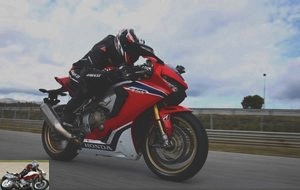 Straight line with the Fireblade SP
Straight line with the Fireblade SP
It is time to take stock of the dynamic behavior of machines. The Fireblades both show great agility in curves. Lively, they move from one angle to another with neutrality and speed. With great precision, the front axle of the CBRs makes it possible to take care of its trajectories to the millimeter and to correct them easily and at any time, the machines reacting finely to the pressure on the footrests. Likewise, the angle stability is remarkable, except on the bumpy sections with standard settings, as such, the SP version does not seem to give much advantage at first glance..
Their very small size coupled with good general ergonomics allows great ease on the handlebars and the Fireblades tolerate rather well the sometimes parasitic movements of the pilot when exiting a curve. As a rule, they forgive a lot of possible approximations.
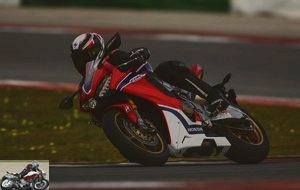 Getting started with the Fireblade SP on the track
Getting started with the Fireblade SP on the track
So we can easily focus on driving. Intuitive, the Honda are piloted by sight and without forcing in the rumble of the four cylinders. The chant is also more present than before, metallic at high speed, helping to strengthen the dynamic presence of the CBRs. Available on intermediate gears from 4,500 rpm, the unit of these vintages demonstrates superior force over a wide range. This higher torque even allows the use of a higher gear without too much strain on the dynamics at mid-range. It is thus fully expressed beyond 6,500 revolutions, then always increasing its thrust and does not lose any of its verve before the breaker at more than 13,000 revolutions. In the large curve which commands the straight line, at 200 km / h at the level of the vibrator, the fast curves highlight the perfect course of the hypersport, but also its lack of protection as the machine is narrow. At 280, my eighty-four meter barely hide behind the anecdotal bubble and the legs must not move a millimeter away from the sides ….
The braking equipment of the two Honda hypersports is excellent. The Tokico calipers bring more progress when the Brembo show them a slightly more frank attack from the front clamps. The decelerations are powerful and constant and allow the latest braking even if the ABS remains sometimes intrusive.
 The SP is better equipped on the cycle side
The SP is better equipped on the cycle side
A final 45-minute test session allows us to judge more of the piloted suspensions. We can indeed configure these elements in a new and very meaningful way, the system does not offer "compression" or "relaxation", but addresses these adjustments in terms of "braking", turn ", acceleration" or more simply "global ". Each variable then makes it possible to ask the suspensions to offer more or less hydraulics on the different piloting phases…. Fork and shock absorber can even be adjusted independently. In addition, two personalized profiles can be kept, as in the Piloting modes.
In dynamics, the changes are noticeable and demonstrate the interest of Honda technology. I thus varied the sports automatic behavior (A1) on the braking and cornering phases, by testing reverse or complementary solutions in turn. The results are tangible, really and finely influencing the performance of the machine. The implementation of ABS is then less sensitive by increasing the compression value (10 increments from +5 to – 5). All piloting profiles are thus served as well as possible, allowing everyone to refine their feeling on the handlebars and improve their passages. Compared to the standard model, the sportiest setting of its adjustments is the average level of the SP…. the margin is therefore important.
The ergonomics of electronic adjustment, rather good, requires to be stopped. That of use, on the other hand, is more questionable in a general way because requires to cut the gas to validate the change. The same goes for the traction control or the engine power modes. Direct action paddles would be welcome to modify a predetermined parameter for example.
Conclusion
The history of the CBR continues its march, always more efficient, but without forgetting the fundamentals which presided over its destiny. The famous weight / power ratio coupled with a precise chassis and ever more demonstrative mechanics make Honda serious and aggressive novelties in the segment. On the SP, the suspensions controlled in automatic mode significantly increase the level of damping and therefore control. Their impressive adjustment possibilities and their efficiency will delight the most demanding and experienced in order to optimize their piloting on each phase. Optimized by an important electronic, the Fireblade sin however by some defects of youth of their chips. If, in absolute terms, the performances are remarkable, certain reactions of the assistants can harm the efficiency of the more athletic. Honda’s electronics do not yet fully reach the level of transparency of their chassis.
 The 2017 Honda CBR 1000 RR Fireblade
The 2017 Honda CBR 1000 RR Fireblade
Nor that of some of their opponents. In particular the Yamaha R1, priced at € 18,999 and R1 M with piloted suspensions € 23,799. The German BMW S1000RR asks for 17,650 €, but also many options. The essential Aprilia RSV4 RR and RF claim € 17,499 and € 20,999 in Ohlins version and racing electronics. Less easy, the Kawasaki ZX-10R is exchanged for € 17,899 and the Ducati 1299 Panigale require € 21,390 and € 26,490 in the S version….
Priced at 17,999 € as standard, the CBR1000RR admits a placed price. For 22,499 € in the SP version, the bill is higher, but the capacities of its piloted suspensions will allow the most demanding and experienced to optimize their piloting on each phase. Attractive, efficient and always so intuitive, the new Honda hypersport have transcended their philosophy to keep the pilot in full control, now under assistance. Precise and safe blades, the Fireblades ignite their performance more than ever.
Strong points
- Engine performance and availability
- Precision and agility of the cycle part
- Powerful braking
- Intuitive handling
- Finishes
- Sleek aesthetics
- Suspensions controlled in auto mode (SP)
Weak points
- Perfectible electronic assistance
- Far too little aerodynamic protection
Honda CBR 1000 RR Fireblade technical sheet
The Honda CBR 1000 RR Fireblade video test
Related articles
-
The small large gas turbine The brand’s historic sports car, the CBR 600 RR is a sure bet for efficiency and performance. Rather than the ultimate quest…
-
Honda Africa Twin CRF1000L test
Honda CRF1000L Africa Twin ABS and DCT version Legends never die. Like the phoenix, the Africa Twin is reborn from the sand of its past exploits in a…
-
Kawasaki Ninja 1000 SX motorcycle test
Compromise without compromise 4 cylinders of 1,043 cm3, 142 hp and 111 Nm, 235 kg, from 14,349 euros In 2010, Kawasaki presented its first Z1000SX, a…
-
The race in the lead Sports motorcycles are often mechanical legends whose rarefaction of renewal increases their exceptional character. Obvious for the…
-
Honda CBR 1000 RR Fireblade motorcycle test
20 years under the sign of total control 1992 saw the appearance of the very first CBR Fireblade, cubing 893 cm3 and has since become a sports icon. At…
-
Kawasaki Versys 1000 SE motorcycle test
3rd evolution for the shock road trail hybrid 4 cylinders in line, 1,043 cm3, 120 hp and 102 Nm, KECS electronic suspensions, 257 kg, 16,899 euros…
-
Honda CBR 1000 RR SP Fireblade test
Easy girl The SP version of the Fireblade pushes the concept of Total Control dear to Honda to its climax, namely offering an ultra efficient machine and…
-
The migratory meaning The spirit of adventure certainly blows through the 2012 motorcycle production. Indeed, no less than three new maxi-trails come to…
-
road crossover: Einstein’s wheel 4 cylinders in line, 999 cm3, 165 hp and 114 Nm, 226 kg, € 17,900 E = MC2. For the boeotians like me, it evokes the…
-
GT-Cruiser of the 3rd type The winged builder keeps up his ideas and keeps revisiting the contemporary bagger style. After the F6B and very soon F6C,…
LOL.
Exactly ! Just the right amount of excess.
Thank you.